A Real-Time Maximum Efficiency Tracker for Wireless Power Transfer Systems with Cross-Coupling
Abstract
:1. Introduction
2. Steady State Equivalent Circuit Analysis
2.1. Frequency Domain Model
2.2. The Effect of Cross-Coupling among Receivers on System Efficiency
- If the ratio of the reflected load resistance to the series resistance of the receiver is the same for both receivers (i.e., ), then the highest efficiency occurs when there is no cross-coupling among the receivers. However, in most applications, the load requirement of the receiver as well as the coupling conditions among the transmitter and receivers keep changing. Hence, the value of keeps varying, as the duty cycle needs to be adjusted to keep the output voltage constant. The relation between and is given in Equation (8).
- If the k-Q factors () of the transmitter and each of the receivers are the same, then the highest efficiency occurs when there is no cross-coupling among the receivers. However, again, the loaded quality factor of the receivers is dependent on the loading conditions of the system and hence on , which keeps varying during system operation as explained in the previous point. Additionally, the coupling coefficient between the transmitter and receiver () keeps varying.
- A higher value of the unloaded quality factor of the transmitter coil () gives a higher probability of having a non-zero optimal coupling coefficient among the receivers.
3. Switched-Capacitor Circuit
4. Efficiency Optimization While Maintaining Voltage Regulation
- An optimum link efficiency of was achievable at and .
- The highest efficiency occurred at the point where the average input current was lowest and hence was quite close to the point where the rms current of the transmitter was lowest.
- Additionally, the link efficiency depends on the rms currents of the receivers as well, but and do not have a linear relationship with efficiency as a function of and , respectively.
5. Real-Time Maximum Efficiency Tracking Algorithm
Procedure
- The relative resonant frequencies are kept at one initially, and the average input current is sensed and recorded. Next, is recorded as the present minimum value of the average input current (). To ensure that the required power can be delivered to the loads for a range of coupling coefficients and load conditions, the input voltage to the system should be set high enough. Additionally, for the range of variation of that is considered, the system should be able to deliver the required power output. This ensures that the buck-boost converter cascaded with the receiver can maintain voltage regulation.
- After achieving output voltage regulation, the of each receiver can be perturbed according to the sequence discussed below. As mentioned before, this can be performed by perturbing the control angle of the switched-capacitor network of the receivers. The change in () can be adjusted based on a gradient descent algorithm and can be written asHere, k is a step size correction term, and is the derivative of the system efficiency with respect to . The gradient descent algorithm can help reach the MEP faster than a hill-climbing algorithm where a fixed step size is applied to . At the beginning of the algorithm, a larger step size is preferred to improve the dynamic response and reach the MEP faster. Toward the end of the algorithm, a smaller step size is preferred for fine-tuning near the MEP. This can be achieved from the formula for step size shown in Equation (32), where due to a higher change in efficiency away from the MEP, the step size is higher. In addition, near the MEP, the change in efficiency is smaller, and hence the step size is smaller, which enables the system to remain very close to the maximum efficiency point and reduces the size of the oscillations around it.
- The relative resonant frequency of receiver 1 is then increased slightly () by reducing the control angle . After the perturbation in the control angle is applied, the duty ratios of the DC-DC converters are changed to maintain a constant voltage at the output. After a delay in time, is measured again and compared with .
- If the measured value of is greater than , then is reduced ().
- If the measured value of is less than , then is increased (). Additionally, is made equal to the current value of .
- This increase or decrease in is repeated in steps until the lowest value of is reached. Here, the iteration for changing is stopped, and is made equal to the current value of . The value of () with the lowest is recorded. To allow for settling of the transients in the system, and for regulating the output voltage, all the increments or decrements to are made after a small time delay.
- In the next step, in a similar way, is increased or decreased (with a similar delay) until the lowest value of is reached. Here, the iteration for changing is stopped, and is made equal to the current value of . The value of ( ) with the lowest is recorded.
- This process is repeated for n receivers, and the optimum efficiency point is obtained.
- In the next iterations, , … are increased or decreased in every step in a direction in which efficiency is improved. When the algorithm ends, the system operates at the values of , …, for which the system efficiency is at its maximum.
- This process starts again from receiver 1 to keep achieving the maximum efficiency in real time with variations in the system parameters.
6. Experimental Results
6.1. Experiment with Full Load on Both Receivers
6.2. Experiment with Full Load on Receiver-1 and 10% Load on Receiver-2
7. Conclusions
Author Contributions
Funding
Data Availability Statement
Conflicts of Interest
Appendix A
References
- Hui, S.Y. Planar Wireless Charging Technology for Portable Electronic Products and Qi. Proc. IEEE 2013, 101, 1290–1301. [Google Scholar] [CrossRef] [Green Version]
- Jang, Y.; Jovanovic, M.M. A contactless electrical energy transmission system for portable-telephone battery chargers. In Proceedings of the Twenty-Second International Telecommunications Energy Conference (Cat. No. 00CH37131), Phoenix, AZ, USA, 10–14 September 2000; pp. 726–732. [Google Scholar] [CrossRef] [Green Version]
- Elliott, G.A.J.; Boys, J.T.; Green, A.W. Magnetically coupled systems for power transfer to electric vehicles. In Proceedings of the 1995 International Conference on Power Electronics and Drive Systems, PEDS 95, Singapore, 21–24 February 1995; pp. 797–801. [Google Scholar] [CrossRef]
- Choi, J.; Tsukiyama, D.; Tsuruda, Y.; Davila, J.M.R. High-Frequency, High-Power Resonant Inverter With eGaN FET for Wireless Power Transfer. IEEE Trans. Power Electron. 2018, 33, 1890–1896. [Google Scholar] [CrossRef]
- Arteaga, J.M.; Aldhaher, S.; Kkelis, G.; Kwan, C.; Yates, D.C.; Mitcheson, P.D. Dynamic Capabilities of Multi-MHz Inductive Power Transfer Systems Demonstrated With Batteryless Drones. IEEE Trans. Power Electron. 2019, 34, 5093–5104. [Google Scholar] [CrossRef]
- Baker, M.W.; Sarpeshkar, R. Feedback Analysis and Design of RF Power Links for Low-Power Bionic Systems. IEEE Trans. Biomed. Circuits Syst. 2007, 1, 28–38. [Google Scholar] [CrossRef]
- Choi, J.; Ooue, Y.; Furukawa, N.; Rivas, J. Designing a 40.68 MHz power-combining resonant inverter with eGaN FETs for plasma generation. In Proceedings of the IEEE Energy Conversion Congress and Exposition (ECCE), Portland, OR, USA, 23–27 September 2018; pp. 1322–1327. [Google Scholar] [CrossRef]
- Elliott, G.A.J.; Covic, G.A.; Kacprzak, D.; Boys, J.T. A New Concept: Asymmetrical Pick-Ups for Inductively Coupled Power Transfer Monorail Systems. IEEE Trans. Magn. 2006, 42, 3389–3391. [Google Scholar] [CrossRef]
- Kurs, A.; Moffatt, R.; Soljacic, M. Simultaneous mid-range power transfer to multiple devices. Appl. Phys. Lett. 2010, 96, 044102-1–044102-3. [Google Scholar] [CrossRef]
- Sugiyama, R.; Duong, Q.; Okada, M. kQ-product analysis of multiple-receiver inductive power transfer with cross-coupling. In Proceedings of the International Workshop on Antenna Technology: Small Antennas, Innovative Structures, and Applications (iWAT), Athens, Greece, 1–3 March 2017; pp. 327–330. [Google Scholar] [CrossRef]
- Li, H.; Li, J.; Wang, K.; Chen, W.; Yang, X. A Maximum Efficiency Point Tracking Control Scheme for Wireless Power Transfer Systems Using Magnetic Resonant Coupling. IEEE Trans. Power Electron. 2015, 30, 3998–4008. [Google Scholar] [CrossRef]
- Fu, M.; Yin, H.; Liu, M.; Wang, Y.; Ma, C. A 6.78 MHz Multiple-Receiver Wireless Power Transfer System With Constant Output Voltage and Optimum Efficiency. IEEE Trans. Power Electron. 2018, 33, 5330–5340. [Google Scholar] [CrossRef]
- Zhong, W.X.; Hui, S.Y.R. Maximum Energy Efficiency Tracking for Wireless Power Transfer Systems. IEEE Trans. Power Electron. 2015, 30, 4025–4034. [Google Scholar] [CrossRef] [Green Version]
- Ahn, D.; Hong, S. Effect of Coupling Between Multiple Transmitters or Multiple Receivers on Wireless Power Transfer. IEEE Trans. Ind. Electron. 2013, 60, 2602–2613. [Google Scholar] [CrossRef]
- Fu, M.; Zhang, T.; Zhu, X.; Luk, P.C.; Ma, C. Compensation of Cross Coupling in Multiple-Receiver Wireless Power Transfer Systems. IEEE Trans. Ind. Inform. 2016, 12, 474–482. [Google Scholar] [CrossRef]
- Laha, A. Modelling and Efficiency Optimization of Wireless Power Transfer Systems having One or Two Receivers. Master’s Thesis, Queen’s University, Kingston, NJ, USA, 2020. [Google Scholar]
- Laha, A.; Kalathy, A.; Jain, P. Efficiency Optimization of Wireless Power Transfer Systems having Multiple Receivers with Cross-Coupling by Resonant Frequency Adjustment of Receivers. In Proceedings of the IEEE Energy Conversion Congress and Exposition (ECCE), Virtual, 10–14 October 2021; pp. 5735–5742. [Google Scholar] [CrossRef]
- Moreland, C. Coil Basics. 2006. Available online: http://www.geotech1.com/pages/metdet/info/coils.pdf (accessed on 23 October 2022).
- Pratik, U.; Varghese, B.J.; Azad, A.; Pantic, Z. Optimum Design of Decoupled Concentric Coils for Operation in Double-Receiver Wireless Power Transfer Systems. IEEE J. Emerg. Sel. Top. Power Electron. 2019, 7, 1982–1998. [Google Scholar] [CrossRef]
- Zhuo, K.; Luo, B.; Zhang, Y.; Zuo, Y. Multiple receivers wireless power transfer systems using decoupling coils to eliminate cross-coupling and achieve selective target power distribution. IEICE Electron. Express 2019, 16, 20190491. [Google Scholar] [CrossRef] [Green Version]
- Pantic, Z.; Lee, K.; Lukic, S.M. Receivers for Multifrequency Wireless Power Transfer: Design for Minimum Interference. IEEE J. Emerg. Sel. Top. Power Electron. 2015, 3, 234–241. [Google Scholar] [CrossRef]
- Zhong, W.; Hui, S.Y.R. Auxiliary Circuits for Power Flow Control in Multifrequency Wireless Power Transfer Systems With Multiple Receivers. IEEE Trans. Power Electron. 2015, 30, 5902–5910. [Google Scholar] [CrossRef]
- Zhang, Y.; Lu, T.; Zhao, Z.; He, F.; Chen, K.; Yuan, L. Selective Wireless Power Transfer to Multiple Loads Using Receivers of Different Resonant Frequencies. IEEE Trans. Power Electron. 2015, 30, 6001–6005. [Google Scholar] [CrossRef]
- Liu, F.; Yang, Y.; Ding, Z.; Chen, X.; Kennel, R.M. Eliminating cross interference between multiple receivers to achieve targeted power distribution for a multi-frequency multi-load MCR WPT system. IET Power Electron. 2018, 11, 1321–1328. [Google Scholar] [CrossRef]
- Kim, Y.; Ha, D.; Chappell, W.J.; Irazoqui, P.P. Selective Wireless Power Transfer for Smart Power Distribution in a Miniature-Sized Multiple-Receiver System. IEEE Trans. Ind. Electron. 2016, 63, 1853–1862. [Google Scholar] [CrossRef]
- Fu, M.; Yin, H.; Ma, C. Megahertz Multiple-Receiver Wireless Power Transfer Systems With Power Flow Management and Maximum Efficiency Point Tracking. IEEE Trans. Microw. Theory Tech. 2017, 65, 4285–4293. [Google Scholar] [CrossRef]
- Song, J.; Liu, M.; Ma, C. Analysis and Design of a High-Efficiency 6.78-MHz Wireless Power Transfer System With Scalable Number of Receivers. IEEE Trans. Ind. Electron. 2020, 67, 8281–8291. [Google Scholar] [CrossRef]
- Cui, D.; Imura, T.; Hori, Y. Cross coupling cancellation for all frequencies in multiple-receiver wireless power transfer systems. In Proceedings of the International Symposium on Antennas and Propagation (ISAP), Okinawa, Japan, 24–28 October 2016; pp. 48–49. [Google Scholar]
- Dai, X.; Li, X.; Li, Y. Cross-coupling coefficient estimation between multi-receivers in WPT system. In Proceedings of the IEEE PELS Workshop on Emerging Technologies: Wireless Power Transfer (WoW), Chongqing, China, 20–22 May 2017; pp. 1–4. [Google Scholar] [CrossRef]
- Xie, X.; Xie, C.; Li, Y.; Wang, J.; Du, Y.; Li, L. Adaptive Decoupling Between Receivers of Multireceiver Wireless Power Transfer System Using Variable Switched Capacitor. IEEE Trans. Transp. Electrif. 2021, 7, 2143–2155. [Google Scholar] [CrossRef]
- Ishihara, M.; Fujiki, K.; Umetani, K.; Hiraki, E. Autonomous System Concept of Multiple-Receiver Inductive Coupling Wireless Power Transfer for Output Power Stabilization Against Cross-Interference Among Receivers and Resonance Frequency Tolerance. IEEE Trans. Ind. Appl. 2021, 57, 3898–3910. [Google Scholar] [CrossRef]
- Borafker, S.; Drujin, M.; Ben-Yaakov, S.S. Voltage-Dependent-Capacitor Control of Wireless Power Transfer (WPT). In Proceedings of the IEEE International Conference on the Science of Electrical Engineering in Israel (ICSEE), Eilat, Israel, 12–14 December 2018; pp. 1–4. [Google Scholar] [CrossRef]
- Lim, Y.; Tang, H.; Lim, S.; Park, J. An Adaptive Impedance-Matching Network Based on a Novel Capacitor Matrix for Wireless Power Transfer. IEEE Trans. Power Electron. 2014, 29, 4403–4413. [Google Scholar] [CrossRef]
- Gu, W.J.; Harada, K. A new method to regulate resonant converters. IEEE Trans. Power Electron. 1988, 3, 430–439. [Google Scholar] [CrossRef]
- Qiu, M.; Jain, P.K.; Zhang, H. An AC VRM topology for high frequency AC power distribution systems. IEEE Trans. Power Electron. 2004, 19, 112–120. [Google Scholar] [CrossRef]
- Zhang, J.; Zhao, J.; Zhang, Y.; Deng, F. A Wireless Power Transfer System With Dual Switch-Controlled Capacitors for Efficiency Optimization. IEEE Trans. Power Electron. 2020, 35, 6091–6101. [Google Scholar] [CrossRef]
- Kobayashi, D.; Imura, T.; Hori, Y. Real-time coupling coefficient estimation and maximum efficiency control on dynamic wireless power transfer using secondary DC-DC converter. In Proceedings of the IECON—41st Annual Conference of the IEEE Industrial Electronics Society, Yokohama, Japan, 9–12 November 2015; pp. 004650–004655. [Google Scholar] [CrossRef]
- Laha, A.; Jain, P. Maximizing Efficiency while maintaining Voltage Regulation of Wireless Power Transfer Systems using a Buck-Boost Converter. In Proceedings of the IEEE Applied Power Electronics Conference and Exposition (APEC), Orlando, FL, USA, 19–23 March 2021; pp. 700–705. [Google Scholar] [CrossRef]


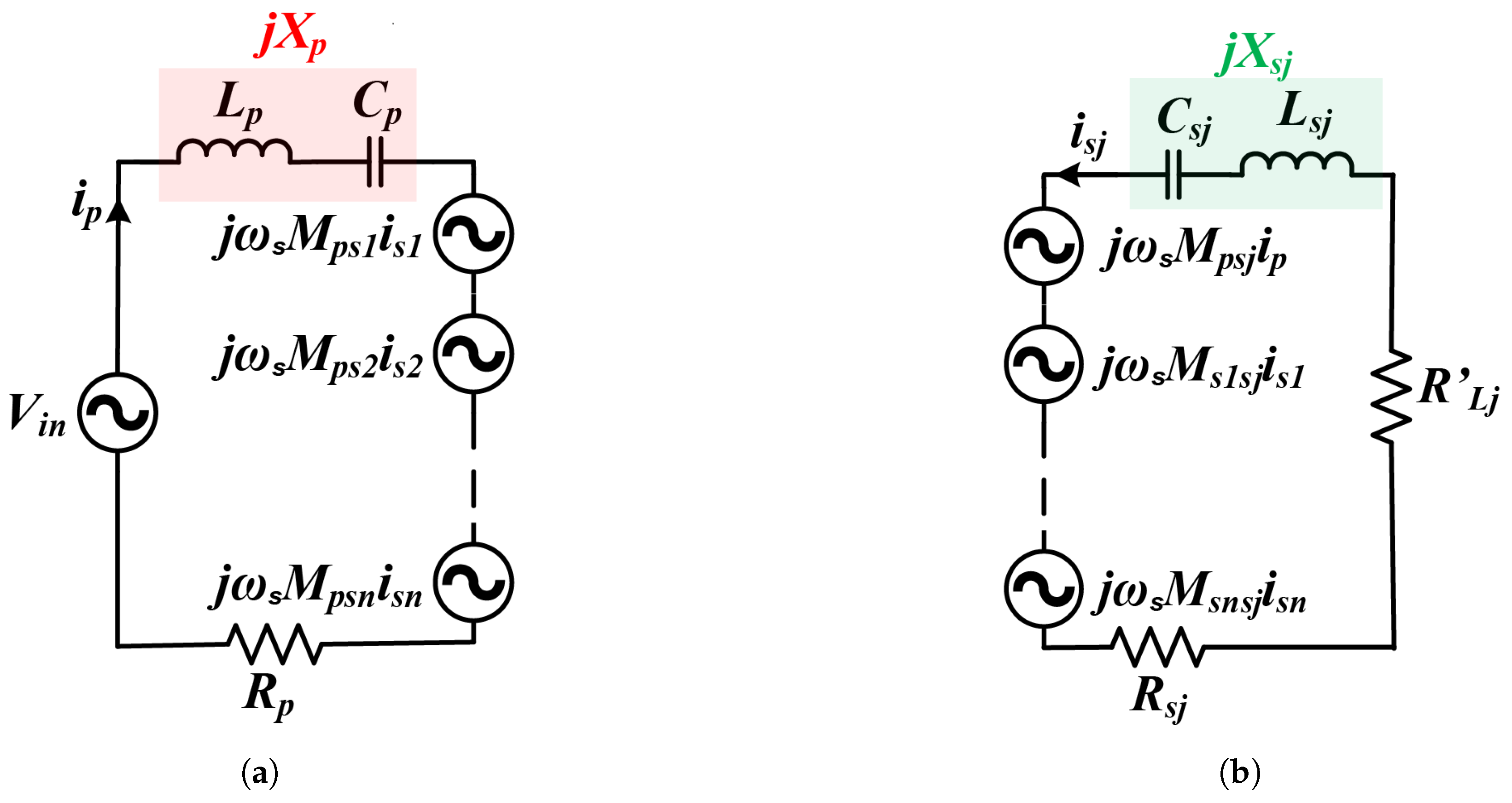
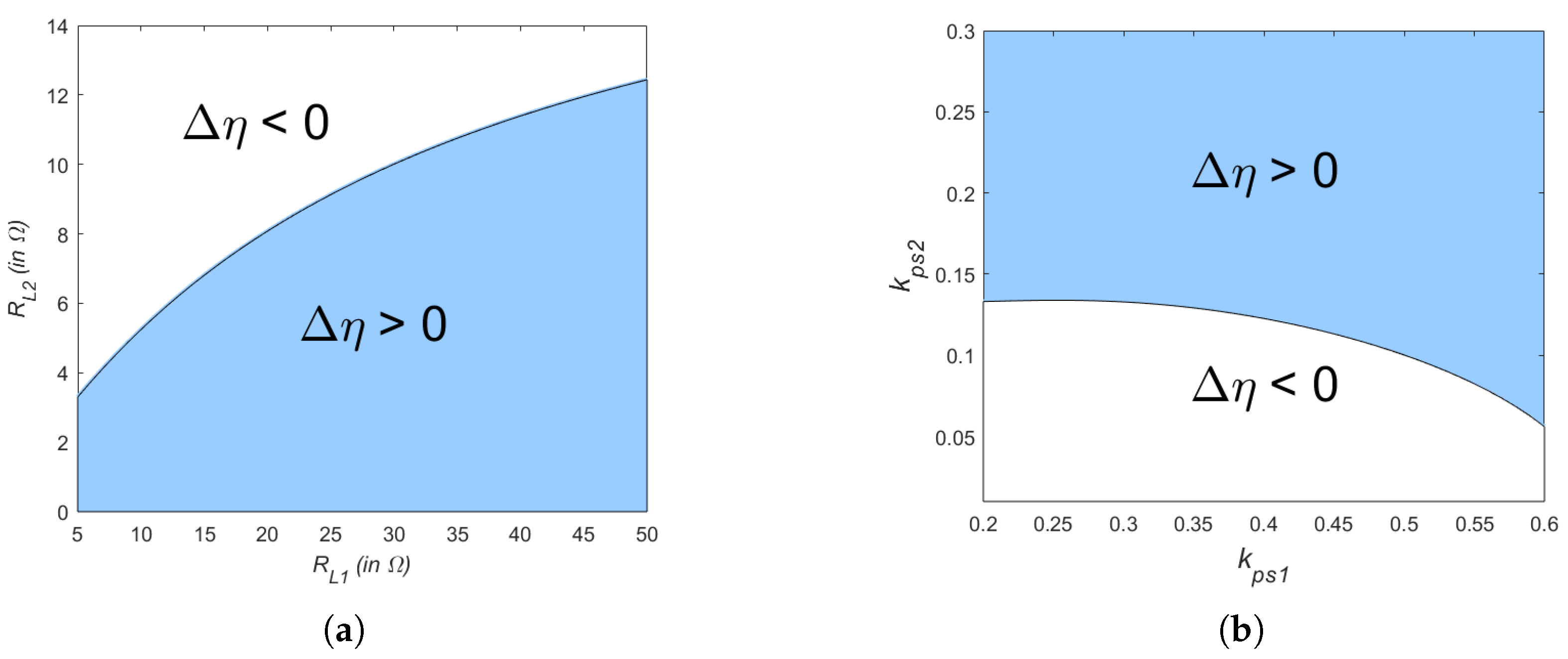
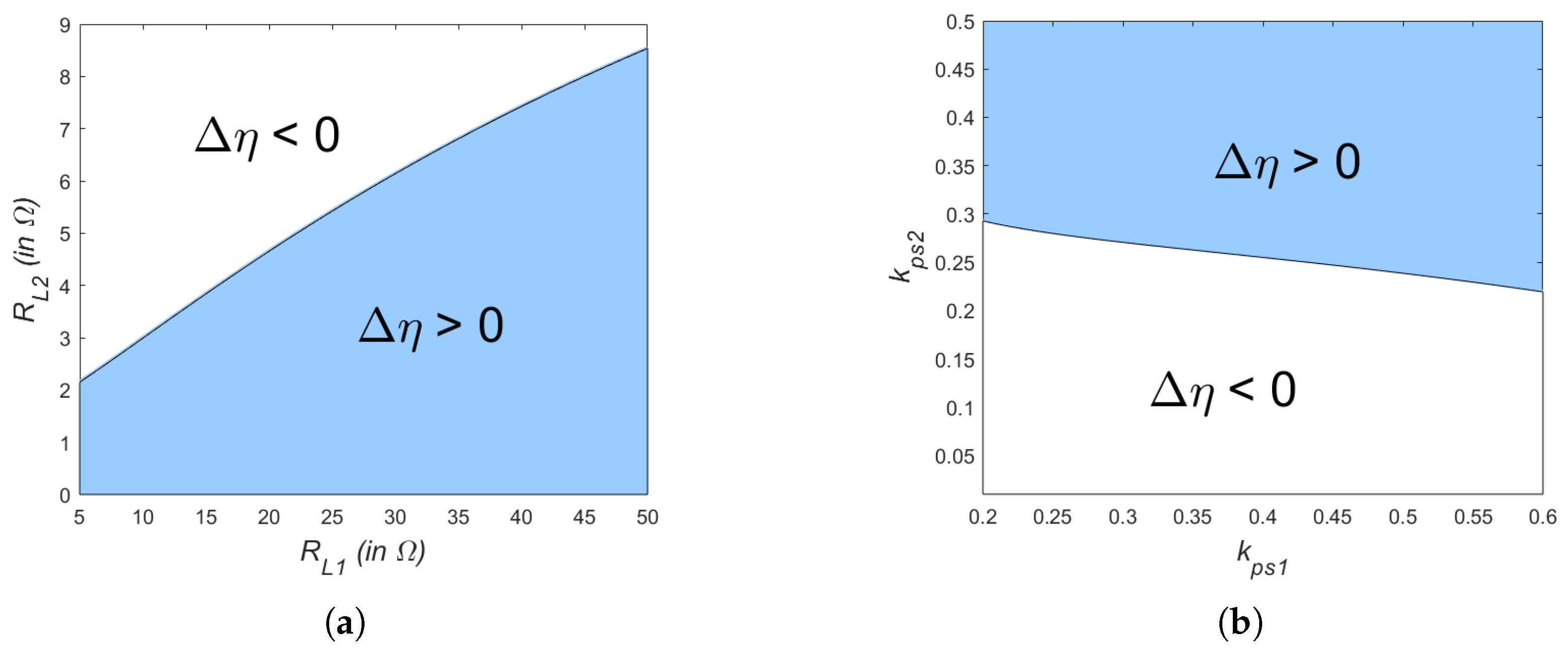
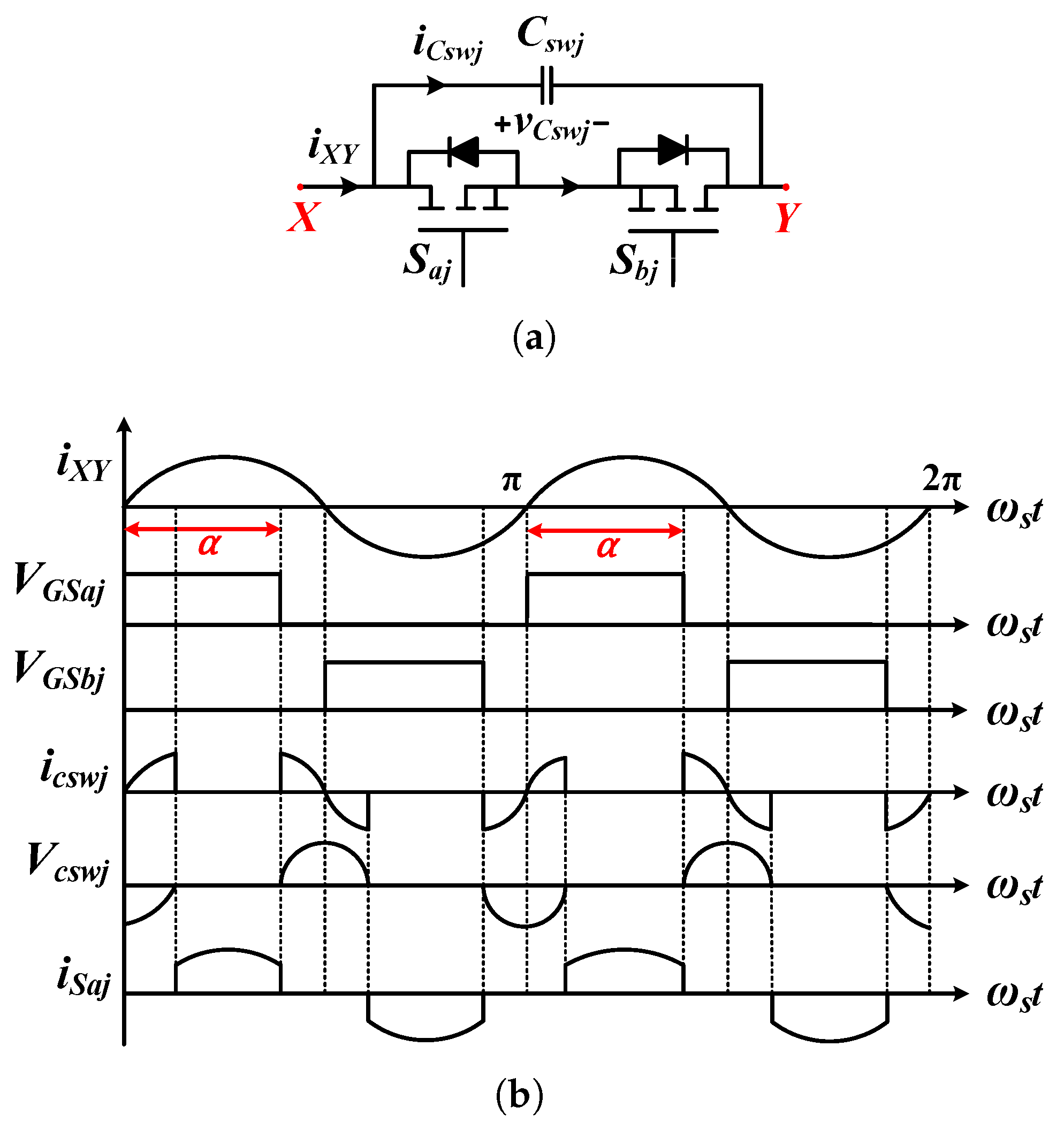


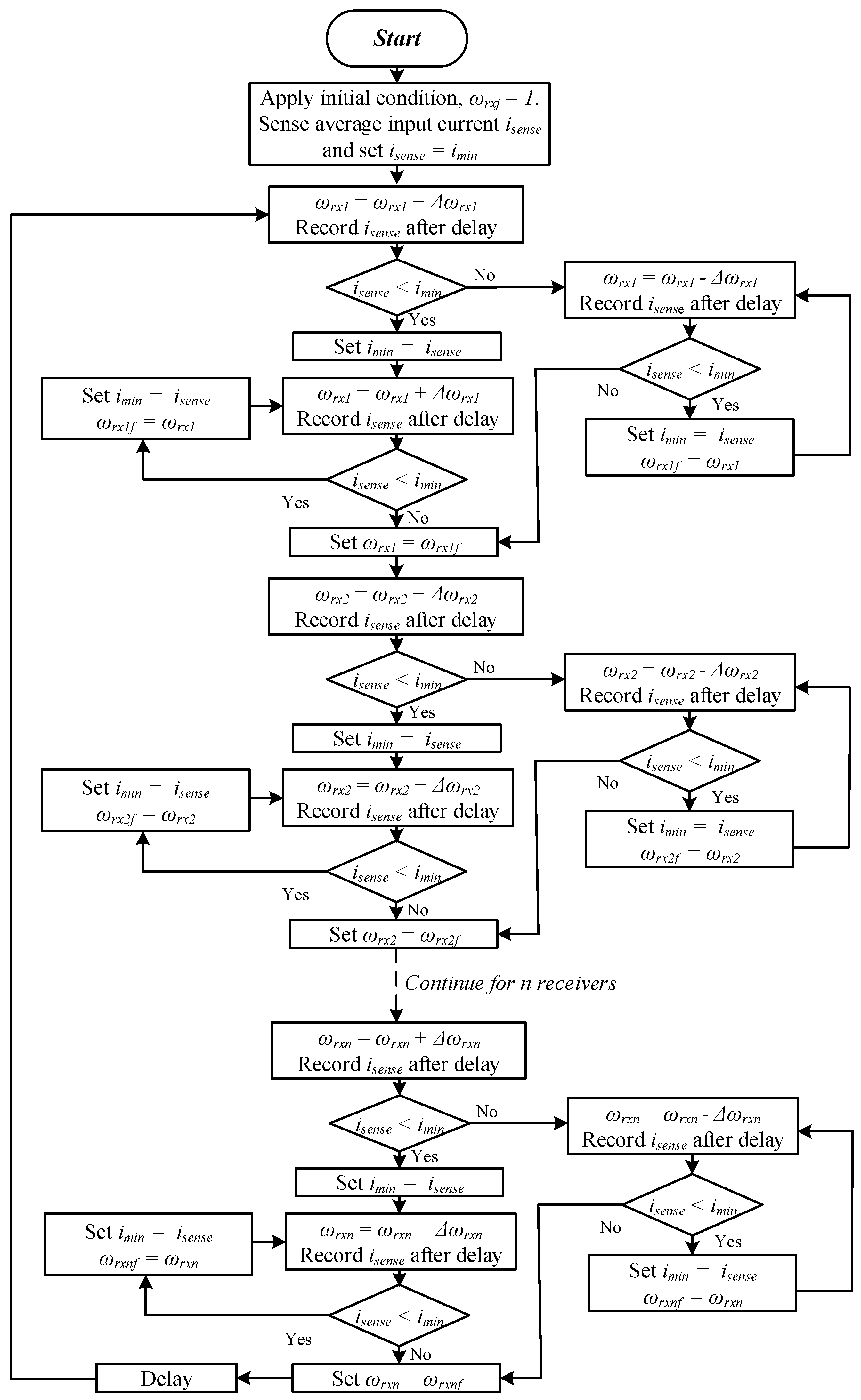
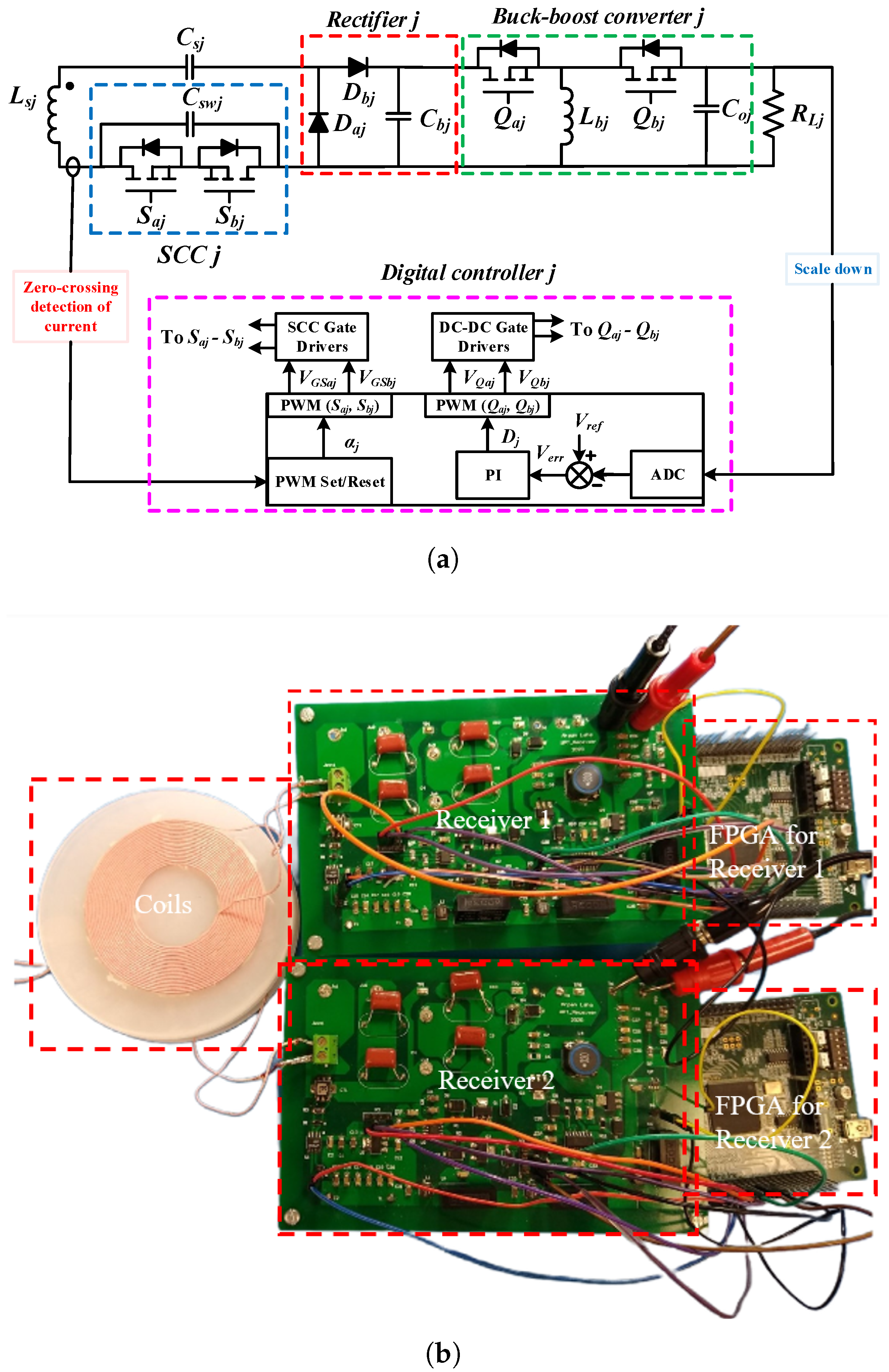






| Symbol | Parameter | Value |
|---|---|---|
| Input voltage | 30 V | |
| Output voltage | 5 V | |
| Rated output power | 5 W | |
| Switching frequency | 200 kHz | |
| Transmitter and receiver coil inductance | 24 H | |
| Transmitter- and receiver-side resistance | 0.3 | |
| Transmitter- and receiver-side capacitance | 26.38 nF |
| Symbol | Parameter | Value |
|---|---|---|
| Input voltage | 30 V | |
| Output voltage | 5 V | |
| Rated output power | 5 W | |
| Switching frequency | 200 kHz | |
| Transmitter coil inductance | 24.2 H | |
| Receiver 1 coil inductance | 23.7 H | |
| Receiver 2 coil inductance | 23.6 H | |
| Transmitter-side resistance | 0.58 | |
| Receiver-side resistance | 0.44 | |
| Receiver-side resistance | 0.45 | |
| Transmitter-side capacitance | 26.38 nF | |
| Receiver 1 capacitance | 26.38 nF | |
| Receiver 2 capacitance | 26.38 nF | |
| Coupling between Transmitter and Receiver 1 | 0.39 | |
| Coupling between Transmitter and Receiver 2 | 0.25 | |
| Coupling between Receiver 1 and Receiver 2 | 0.65 |
| Research Works | Simultaneous Power Transfer to Multiple Receivers | Requirement of Estimation Techniques | Possibility to Add More Receivers After Design | Complexity of Design | Operating Range of Load and Coupling |
|---|---|---|---|---|---|
| Coil decoupling [18,19,20] | Yes | No | No (Coils need to have a specific design for a specific number of receivers.) | Medium (Coil design can be complicated for more than two receivers.) | Narrow |
| Multi-resonant [21,22,23,24] | Yes | No | Yes (However, the number of receivers is limited by the available frequencies.) | Medium (Needs additional circuitry for filtering noise and avoiding interference with other receivers.) | Narrow |
| Time division multiplexing [25,26] | No | No | Yes (However, addition of more receivers further limits duration of power delivery.) | Low (Design is straightforward, as one receiver is powered at a time.) | Wide |
| Passive compensation [27] | Yes | No | No (Coils and compensation networks need to be redesigned for more receivers.) | Low (Design is fairly straightforward once the number and specifications of target receivers are finalized.) | Narrow |
| Active reactance compensation [15,28] | Yes | Yes | Yes (However, more parameters would need estimation to apply the required reactance to the receivers.) | High (Estimation algorithms for system parameters could be computationally intensive.) | Wide |
| Current quadrature phenomena [30,31] | Yes | No | Yes (However, phase information of the transmitter current is required to be communicated to the receivers.) | Medium (Needs automatic tuning assist circuit or switched capacitor circuits for orthogonalization of the transmitter and receiver currents.) | Narrow |
| Proposed technique | Yes | No | Yes (Power can be delivered to more receivers within the rating of the transmitter components.) | Medium (Needs additional switched-capacitor circuit for modulating receiver reactance.) | Wide |
Publisher’s Note: MDPI stays neutral with regard to jurisdictional claims in published maps and institutional affiliations. |
© 2022 by the authors. Licensee MDPI, Basel, Switzerland. This article is an open access article distributed under the terms and conditions of the Creative Commons Attribution (CC BY) license (https://creativecommons.org/licenses/by/4.0/).
Share and Cite
Laha, A.; Kalathy, A.; Pahlevani, M.; Jain, P. A Real-Time Maximum Efficiency Tracker for Wireless Power Transfer Systems with Cross-Coupling. Electronics 2022, 11, 3928. https://doi.org/10.3390/electronics11233928
Laha A, Kalathy A, Pahlevani M, Jain P. A Real-Time Maximum Efficiency Tracker for Wireless Power Transfer Systems with Cross-Coupling. Electronics. 2022; 11(23):3928. https://doi.org/10.3390/electronics11233928
Chicago/Turabian StyleLaha, Arpan, Abirami Kalathy, Majid Pahlevani, and Praveen Jain. 2022. "A Real-Time Maximum Efficiency Tracker for Wireless Power Transfer Systems with Cross-Coupling" Electronics 11, no. 23: 3928. https://doi.org/10.3390/electronics11233928





